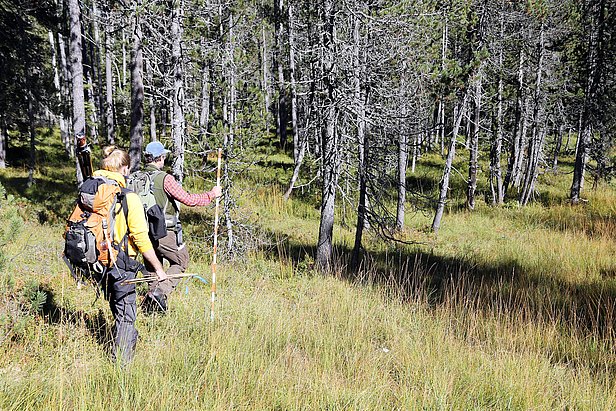The federal government's "Forest Biodiversity" strategy, under which natural forest reserves are promoted, has been in place since the Federal Law on Forests was revised in 1991. We offer scientific support for this development through the "Research and effectiveness controlling in Swiss forest reserves" partnership project of the WSL, ETH and FOEN. It has been part of the Confederation's environmental monitoring programme since 2017.
Contents ¶
The Swiss forests have been exploited intensively for centuries. The surviving remains of the old-growth forest are small. Since 1991, when the Swiss Forestry Act was revised, the Confederation has been supporting the creation of natural forest reserves through its Forest Biodiversity Strategy. These areas are expected to become similar to old-growth forests over decades.
At the end of 2018, the natural forest reserves covered 46,199 hectares, which corresponds to 3.5% of the forested area in Switzerland. There are also forest reserves in which additional nature conservation objectives are pursued on sub-areas, such as the promotion of certain species; these are referred to as complex forest reserves.
The Confederation is interested in learning about the effectiveness of its reserve policy. What does forest development look like in natural forest reserves? Are there actually differences to managed forests, and if so, what are they? For scientists, natural forest reserves are unique open-air laboratories in which they can study forest development and biodiversity.
Swiss natural forest research ¶
We have been researching forest dynamics in a network of Swiss forest reserves and in the primeval forests of the Ukrainian Carpathians for around 80 years. Since 2006, we have joined forces with the the ETH and FOEN in the long-term research project "Monitoring Swiss Natural Reserves". As part of this project, a standardised, practicable method has been developed for a Swiss natural forest monitoring system. A large area of the ETH reserves is still under observation; a portion has been discontinued in order to enable incorporating additional reserves to the observation programme, which will complement it appropriately. There are now 49 reserves under observation which cover the vegetation types throughout Switzerland. They are described in the book “Waldreservate” (now only available from the WSL).
Objectives of the research project ¶
The objectives of the research project are:
- Scientific monitoring of forest development in a network of natural forest reserves
- Evaluate the collected data and publicate the findings
- Provide natural forest indicators for the environmental monitoring programmes of the Confederation



Contact ¶
Services and products ¶
Implementation publications ¶
Scientific publications ¶
Links ¶
- WSL research group "Stand dynamics and silviculture"
- Chair of Forest Ecology at ETH Zurich
- Forest reserves (FOEN, in German, French and Italian)
- Bödmeren Primeval forest (in German)
- Leitsätze einer "Waldreservatspolitik Schweiz" (PDF file in German)
- Swiss Biodiversity Monitoring BDM
- Database of natural forest reserves in Germany (in German)
- The Bavarian State Institute of Forestry (LWF)
- NW-FVA Northwest German Forest Research Institute (in German)

